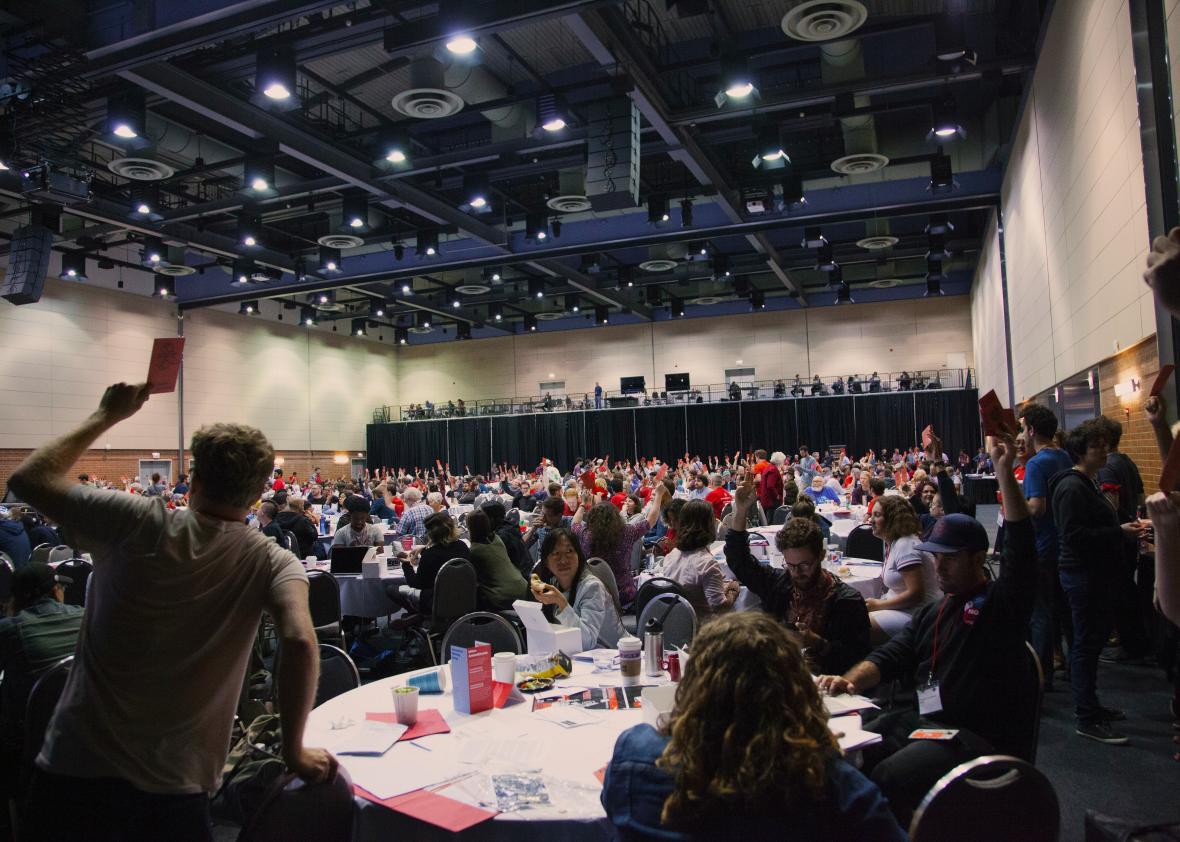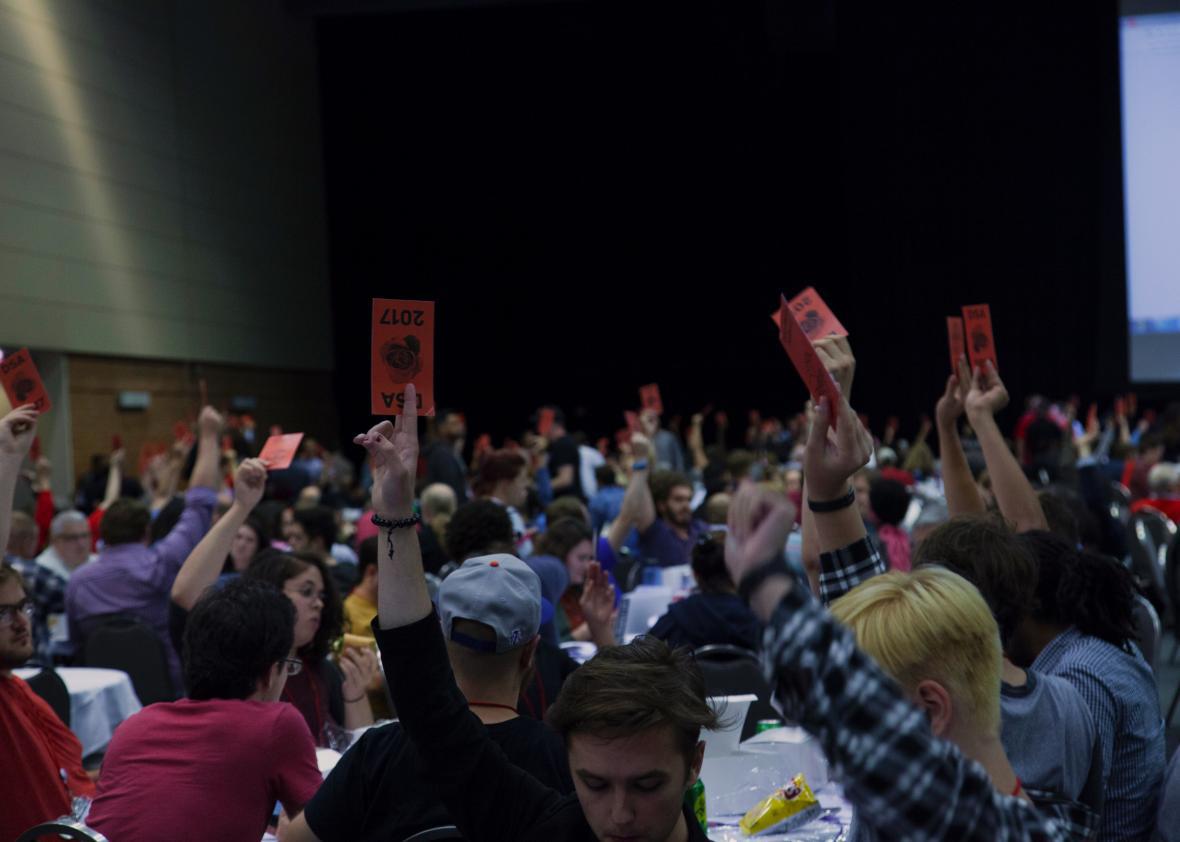Nearly 1,000 socialists from around the country have gathered in Chicago for the Democratic Socialists of America’s biannual conference. They come just as the organization’s reached a milestone: There are now more than 25,000 official DSA members, a threefold increase from a year ago—after Bernie Sanders’ campaign demonstrated that a large mainstream constituency is willing to vote for a self-described socialist and before Trump’s surprise victory in November, which has heightened angst over the state of the Democratic Party and liberalism more broadly. Defenders of the Democratic mainstream routinely point out that unlike the DSA, the Democrats have a base of tens of millions of voters and ballot access. But the DSA isn’t a political party, although some would like to change that. What it is, precisely, and what it ought to become are up for discussion here in Chicago.
There aren’t hard numbers about the DSA’s membership overall, but a picture of what their rank and file looks like emerged with the conference’s first events on Thursday evening. Most of the attendees seem to be under the age of 35 with a smaller but large contingent of old-timers who’ve been with the organization for many years. There are young, scruffy, and often bearded men aplenty who fit the BernieBro stereotype. But according to the DSA’s figures on delegates in attendance, 40 percent of the Chicago crowd are women, and 20 percent are people of color.
Kristian Hernandez, a self-described “angry brown woman,” was one of the speakers on a panel about organizing in the Trump era. Her speech advanced a case for making defending the rights of undocumented immigrants a central part of the DSA’s agenda and a case against the idea “that a person cannot be radical unless they’ve read Karl Marx.” “I don’t subscribe to the belief that there is a threshold to meet to be considered a socialist,” she said. “There’s no required reading, no checklist. The beauty in our ideology is that many already hold the ability to accept the reasons why oppression exists.”
But officially, the DSA does, in fact, define a threshold. Its 2016 “Resistance Rising” strategy document identifies its ultimate goal as the “radical democratization of all areas of life, not least of which is the economy.” Politically, this entails reforms like national referenda, proportional representation, and the abolition of the Senate. Economically, it entails the abolition of capitalism. “Under capitalism we are supposed to take for granted that a small, largely unaccountable group of corporate executives should make all fundamental decisions about the management of a company comprised of thousands of people,” Resistance Rising reads. “This group has the power to determine how most of us spend the lion’s share of our waking hours, as well as the right to fire anyone for basically any reason, no matter how arbitrary. Under democratic socialism, this authoritarian system would be replaced with economic democracy.”
That means, literally, the democratic governance of all firms by employees and local communities and the subjection of certain large industries—such as utilities, health care, and housing—to government planning and decommodification. Firms in most other industries, while “worker-owned and -operated,” would remain subject to market forces.
This long-term vision separates democratic socialists not only from less democratically oriented and market-tolerant socialists (and communists) to their left, but also from the figure most responsible for their recent growth, Bernie Sanders. His self-description as a socialist and possibly more radical personal politics aside, the Sanders presidential campaign offered a progressive liberal agenda in keeping with the priorities that the Democratic Party’s left wing has advanced for years. A socialist will tell you that there exists a world of difference between saying, as Sanders often does, that no one working 40 hours a week should live in poverty and saying that poverty ought to be eradicated altogether—a goal shared by DSA founder Michael Harrington and the Democratic Party of the 1960s and 1970s, which Harrington advocated working with and within.
Additionally, while Sanders supported single-payer health care and a $15 minimum wage, policy goals the DSA actively supports and organizes around, he didn’t advance proposals like a job guarantee or a universal basic income—policies currently being vigorously debated on the left and trickling into mainstream liberal discourse—or talk about the more fundamental reconstitution of the economy the DSA envisions.
Importantly, the DSA sees policies like single-payer—ultimately a compromise position from the full elimination of profit from the provision of health care, which many DSA adherents hope for—as strategic steps toward that reconstitution. The DSA wants single-payer not just because they believe people have a right to health care but also because single-payer and policies like it help fundamentally shift the power dynamics between labor and the owners and managers of capital. These policies give workers more independence and economic leverage, which they can use to push for even more radical proposals, perhaps culminating ultimately in an economy democratically directed by workers.

Sean Michael Duffy/DSA
In sum, the DSA would like to dismantle much of American life as it presently exists. Superficially, the group’s rapid growth might suggest that the number of people willing to commit themselves to this project grows by the thousands every month, with particularly large spikes owing to the election in November and Trump’s inauguration in January. But it seems probable that the Sanders-driven influx comprises more progressives sick of losing elections and eager to see the Democratic Party take on more ambitious domestic policy aims than it does people who have had epiphanies regarding questions of political economy over the past six months. Those progressives now share a large and increasingly crowded tent with members who have always wanted to see the DSA move further left. During the “Socialism Across Generations” panel on the first evening of the conference, the American Prospect editor-at-large Harold Meyerson’s self-description as a “third generation Menshevik”—the moderate faction that clashed with Lenin’s Bolsheviks during the Russian Revolution—drew a few half-serious boos from the audience.
The potential ideological tensions among members might be part of the reason why the convention’s organizers have taken pains to repeatedly encourage civility. In every packet of documents handed out to attendees there is a set of “guidelines for respectful discussion,” which contains advice such as, ”assume good faith in your fellow comrades,” and “please ask yourself ‘why am I talking?’ ” “Many people from different backgrounds have different definitions of what it means to be an ‘activist’ or ‘radical,’ ” it reads. “While we don’t have to agree on everything, we should respect our diversity of opinions. Recognize that everyone has a piece of the truth, everybody can learn, and everybody has the ability to teach and share something.”
The guidelines also include language aimed at encouraging inclusivity, reflecting both the DSA’s commitment to expanding its tent beyond white guys and the movement’s ideological commitments to taking on not only what it sees as class oppression but also what Resistance Rising calls “systems of oppression” based on race, gender, sexual orientation, and ability. The badges handed out to all attendees have spaces for the disclosure of gender pronouns, and a variety of speakers have spoken to the importance of advancing “socialist feminism.” A resolution up for debate this weekend is on the abolition of prisons, one of the planks inspired by the Black Lives Matter movement. Organizationally, the DSA mandates that half of the slots on its 16-member National Political Committee, which functions as a kind of board of directors, be reserved for women and that at least four spots go to racial minorities.
Growing the DSA will, of course, require outreach to minority communities and other currently underrepresented constituencies. There is broad optimism all around that this can happen, and that the Trump administration will continue to bring in new converts. During a report on the DSA’s budget, however, treasurer Theresa Alt tempered expectations. “There was an earlier period of horror at what was going on in Washington combined with euphoria about the power and promise of DSA,” she said. “In the early 1980s under Reagan, people flocked to join DSA, but mostly they didn’t last. By the mid-1990s, DSA was declining in both resources and membership.”
“We’ve always been an organization that makes it easy for people to join,” former national director Frank Llewellyn says. “If it’s easy to join it’s also easy to leave.”
“One of the ways you lose people sometimes is you don’t have something for somebody to do,” he continues, arguing that the paucity of campaigns for new members to take roles in during the organization’s previous eras undermined retention. With the DSA’s chapters today organizing around issues ranging from health care and immigration to climate change and housing, this seems like less of a risk. “So I feel very good about the organizing opportunities that we have and we’ll take advantage of that,” he says. “I feel less good about the state of the country, but I’m quite optimistic.”
